What Year Did The Psp Come Out
Overview
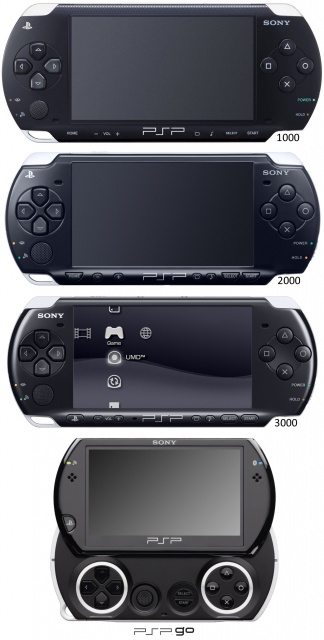
The PlayStation Portable (or PSP) was released March 24, 2005 and marked Sony'southward first entry into the handheld gaming market.
In tardily 2007, the PSP was upgraded with a new hardware variation known by the model number PSP-2000.
On August 20, 2008, at the Leipzig Games Convention, Sony appear a new revision of the PSP, the PSP-3000.
On June 2, 2009, at E3 in Los Angeles, Sony announced the PSPgo, which removed the UMD drive and instead was the first dedicated gaming handheld to be completely dependent on downloaded software.
In August, 2011, at Gamescom in Cologne, Sony announced the budget priced PSP-E1000 for PAL regions, which retained a UMD drive only removed network back up. This would exist the last revision of the PSP.
PSP-2000 (PSP Slim)
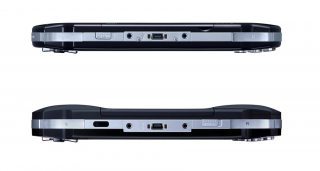
During the E3 conference of 2007, Sony released several details about the PSP's first hardware revision. The model number is PSP-2000, then commonly referred to equally the PSP Slim. The Slim replaced the original (or ''phat'') PSP on the market and had pregnant hardware changes. The corporeality of RAM in the PSP-2000 was doubled from 32 megabytes to 64 megabytes. This added RAM was primarily used to subtract UMD load times, and to improve the retentivity limit when browsing web pages. The Slim's battery was manufactured to supply the same amount of playtime equally the Phat battery while attaining a smaller form factor. The WLAN switch was relocated to the top of the device, and the UMD drive at present required the user to open it manually, equally opposed to the jump-loaded version in the PSP-1000 that was activated using a switch.
The PSP Slim was released in September of 2007.
PSP-3000 (PSP Brite)
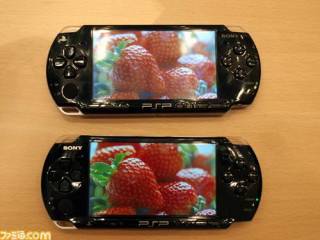
Sony officially announced the PSP-3000 at the 2008 Leipzig Games Convention. Improvements over the PSP-2000 included a built in mic and an improved LCD screen. The new screen features twice the colour gamut, v times the contrast ratio, and a response time that is twice as fast as the PSP-2000's LCD screen. It besides features a new anti-reflective technology for improved viewing of the LCD screen in outdoor areas.
The PSP-3000 was released in Nippon, Europe and North America in October.
PSPgo
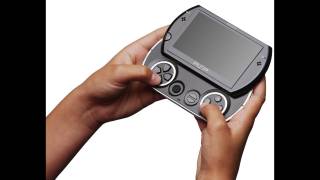
During E3 2009, Sony revealed the PSPgo, (or PSP Go) the lightest and most physically compact PSP model. This portability is achieved using a slide-out form cistron, a smaller screen (3.8 inch screen as opposed to the 4.3 inches on all other models), and the removal of the UMD drive, limiting the system to digitally downloaded games but. Nether the hood, PSPgo is identical to other PSP models, with the same capabilities and Bone, while also adding 16GB internal flash retentivity and PS3 controller support . However, the lack of UMD drive, which physically prevents it from playing disc-based games, resulted in the PSP Go being a consummate commercial failure.
The 16GB internal storage space can be expanded by the utilise of Sony's proprietary M2 Memory Stick, unlike the other models of PSP, which use the Retentivity Stick ProDUO. The PSPgo existed alongside the PSP-3000 when it launched on October 1st, 2009, and unlike other PSP revisions was not intended past Sony to be a replacement for existing models.
The device proved unpopular with many gamers for various reasons, most notably the fact that PSP game discs could not exist played on the PSPgo. Even if y'all own a game on disc, in order to play information technology yous would take to repurchase and download the game from PSN, often at a marked upward price. To brand matters worse, certain PSP titles were never made available for digital download at all, making the PSPgo unattractive even to gamers who did not yet own a PSP.
Other issues include the fact that PSN games tend to be overpriced, the slow download speeds on PSP systems in general, new games being listed incorrectly in PSN store, the fact that some games suffering from glitches non found in their UMD counterparts, and poor customer service.
PSP-E1000
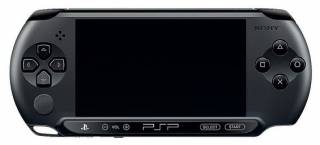
Announced at Gamescom 2011, the PSP-E1000 is a budget-priced PSP available only in PAL territories. Reversing course from the PSPgo, the PSP-E1000 includes a UMD drive, but does not include any network capabilities whatsoever. Slightly larger and heavier than the PSP-3000, the PSP-E1000 has a charcoal black plastic matte trunk similar to the slim PS3 redesign. The layout is fairly similar to the original PSP, withal it moves the organisation buttons to a single row below the screen which is flush with the instance itself. To save on costs, the PSP-E1000 removed WiFi and has only one speaker instead of 2. Despite the lack of wireless connectivity, PSN content could still be accessed past connecting the PSP-E1000 to a Playstation three, or to a PC via USB and using Sony's Media Go software.
The PSP-E100 launched at a cost of €99.99 or £85.
Reception
Shown off at E3 2004, the portable was highly predictable and idea of past many at the time to be superior to the Nintendo DS which was launching around the same time.
Still, leadIng up to launch whispers of long load times and a short battery life began appearing online. These criticisms were true and information technology was something that would haunt the system for a majority of it's life.
Another hamper to the arrangement was a divided perspective of the handheld market. During its first few years, the PSP would ofttimes get ports or sequels of panel games that many felt were ill-suited for the portable market. By 2006 and standing into 2007, several of these PSP titles were ported to Playstation 2.
Rampant piracy was also an issue for third parties. The PSP was hands hackable and guides on how to bypass the arrangement'due south security were easily available on the web. Sony attempted through several firmware updates to make hacking the system more difficult merely the wheels were already in move.
Past mid-2008 the once promising handheld's library looked barren with few games being released apart from ports. Sony would try in 2009 to give the arrangement ane concluding serious push with titles like Rockband Unplugged and Motorstorm Arctic Edge simply at that point much of the damage had already been done.
Despite this the PSP is however remembered for its best games and for being the most successful dedicated gaming handheld that wasn't fabricated by Nintendo. The arrangement is also known amidst gamers for its homebrew scene which Sony badly tried to put a lid on.
In Japan, the PSP continued to be phenomenally successful well by the launch date of the Playstation Vita, (the PSP'southward successor) and even outselling the Nintendo DS and 3DS for a period of fourth dimension.
Launch Titles
Japanese launch titles
- Armored Core: Formula Front
- Mahjong Fight
- Minna no Golf Portable
- Lumines
- Ridge Racers
- Vampire Chronicle: The Chaos Tower
North American Launch Titles
- Ape Escape: On the Loose
- Darkstalkers Chronicle: The Chaos Tower
- Dynasty Warriors
- Gretzky NHL
- Lumines
- Metal Gear Acid
- NBA
- Need for Speed Cloak-and-dagger: Rivals
- NFL Street ii Unleashed
- Ridge Racer
- Spider-Man two
- Tiger Forest PGA Tour
- Tony Militarist's Undercover 2 Remix
- Twisted Metal: Head-On
- Untold Legends: Brotherhood of the Blade
- Wipeout Pure
- Globe Bout Soccer
- Expressionless to Rights Reckoning
- Midnight Club 3: DUB Edition
- MVP Baseball
- Smart Flop
- Hot Shots Golf game: Open Tee
- NBA Street Showdown
- Rengoku: Tower of Purgatory
- FIFA Soccer
- ATV Offroad Fury : Blazin' Trails
- MLB
- Mercury
European Launch Titles
- Ape University
- Archer Maclean's Mercury
- Colin McRae Rally 2005
- Darkstalkers Relate: The Chaos Tower
- Dynasty Warriors
- Everybody's Golf Portable
- Fired Up
- Kao Challengers
- Lumines
- MediEvil Resurrection
- Metal Gear Acrid
- Midnight Gild 3: DUB Edition
- Need for Speed Undercover: Rivals
- Ridge Racer
- Smart Bomb
- Spider-Man ii
- TOCA Race Driver two
- Tony Hawks Secret 2 Remix
- Untold Legends: Alliance of the Blade
- Virtua Tennis: Earth Tour
- Wipeout Pure
- World Snooker Championship 2005
- Globe Tour Soccer: Challenge Edition
- World Rally Title
UMD
'Universal Media Discs' are used by the PSP for games and movies. They are pocket-size circular discs in a plastic casing. All PSP models except the PSPgo support this format, and various games include firmware updates for the PSP on their disc.
Some movies available on UMD are now included on Blu-Ray releases. The user can download a PSP version of the flick from their PS3 to the PSP or PSPgo. Some examples are Godzilla and The Ugly Truth.
Copies of Lumines featured an older firmware update which many users bought and installed to unlock their PSP. At the time this firmware update left the PSP easier to unlock. More recent firmware updates brand this harder to exercise.
Media Functionality
The PSP plays most MP3 and AVC music files. The PSP's video playback options are far more limited, however. The PSP tin can play picture show downloads and rentals from the Playstation Video shop, but playing your own movies more often than not requires a file converter as the PSP does non back up the vast majority of movie files.
Videos, games, and music can all be managed on the PSP past connecting information technology to your PC via a USB cable. Sony also distributes costless software named Media Go, which allows users to download PSN content from their PC.
Each PSP requires a Memory Stick Pro Duo, which is a proprietary memory stick format created by Sony. The memory stick is typically sold separately.
Custom Firmware and Homebrew
The PSP was very well known for it'southward Custom Firmware scene. By opening up the battery and cutting a part of it, you could install Custom Firmware which allowed users to run unsigned software, which allowed ISOs of PSP games, emulators, and homebrew. It was afterward fabricated even easier, because past some point yous could merely do it from files on the Retention Stick. Throughout the PSP's life, Sony tried to put a chapeau on this and kept updating the firmware, plugging upwards exploits each time, which made them infamous in the Homebrew scene. Now that the PSP has been discontinued, information technology'due south very easy to mod them, even on hardware revisions that were unmoddable during a good portion of their life, including the PSP go.
Specifications
| CPU | MIPS R4000-based; clocked from one to 333 MHz |
| Storage Capacity | PSP1000/2000/3000: Memory Stick Duo and Memory Stick PRO Duo (1, ii, 4, viii, 16, 32, 64 or 128 GB) PSPgo: Memory Stick M2 |
| Retentiveness | 32 MB (1000 model) or 64 MB (2000, 3000, and PSP Become models) |
| Display | 480 × 272 pixels with 16.eight million colors, sixteen:9 widescreen TFT LCD, 3.8 in (97 mm) (PSP Become), four.3 in (110 mm) (All other models) |
| Connectivity | Wi-Fi (802.11b),IrDA, USB |
| Dimensions | PSP1000: 74 mm (ii.9 in) (h) 170 mm (6.vii in) (w) 23 mm (0.91 in) (d) PSP2000/3000: 71 mm (two.8 in) (h) 169 mm (half dozen.7 in) (west) 19 mm (0.75 in) (d) PSPgo: 69 mm (2.7 in) (h) 128 mm (5.0 in) (w) xvi.5 mm (0.65 in) (d) |
| Weight | PSP1000: 280 grams (ix.9 oz) PSP2000/3000: 189 grams (6.7 oz) PSPgo: 158 grams (v.6 oz) |
What Year Did The Psp Come Out,
Source: https://www.giantbomb.com/playstation-portable/3045-18/
Posted by: petersenknoter.blogspot.com


0 Response to "What Year Did The Psp Come Out"
Post a Comment